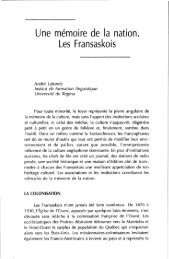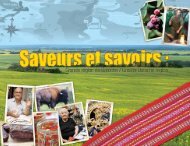Revue Saveurs et savoirs - Partie 2 (.pdf) - Assemblée ...
Revue Saveurs et savoirs - Partie 2 (.pdf) - Assemblée ...
Revue Saveurs et savoirs - Partie 2 (.pdf) - Assemblée ...
Create successful ePaper yourself
Turn your PDF publications into a flip-book with our unique Google optimized e-Paper software.
Le lait <strong>et</strong> ses transformations<br />
Milk and Milk Processing<br />
Le lait était pour les fermes une production de<br />
rente. La crème <strong>et</strong> le p<strong>et</strong>it lait étaient séparés<br />
grâce à un séparateur <strong>et</strong> la crème était vendue<br />
aux laiteries locales qui se chargeaient de la<br />
collecte. Le p<strong>et</strong>it lait servait généralement à<br />
alimenter les cochons. Une partie de la crème<br />
était conservée pour la consommation familiale<br />
<strong>et</strong> la fabrication du beurre. Certains parlent<br />
encore de la saveur exceptionnelle des crèmes<br />
glacées faites maison.<br />
Robert GAREAU ne se contente pas de travailler le<br />
bois. Entre autres talents, il écrit des livres <strong>et</strong> des<br />
pièces de théâtre. Vous trouverez ci-dessous un<br />
extrait de « La saga des GAREAU » (Éditions de la<br />
nouvelle Plume, 1999) dans lequel il présente la<br />
transformation du lait en crème <strong>et</strong> en beurre.<br />
For farms, milk was a cash production.<br />
Cream and whey were separated using a<br />
separator and the cream was sold to local<br />
dairies which looked after collecting it. The<br />
whey was usually used to feed hogs. Part of the<br />
cream was kept for the family’s consumption<br />
and to make butter. Some people still talk<br />
about the exceptional flavour of homemade<br />
ice cream.<br />
Robert GAREAU isn’t content just to do<br />
woodworking. Among his other talents, he<br />
writes books and plays. Below, you’ll find<br />
an excerpt from La saga des GAREAU<br />
(Éditions de la Nouvelle Plume, 1999) in which<br />
he describes the transformation of milk into<br />
cream and butter.<br />
Robert Gareau<br />
La fabrication de la crème <strong>et</strong> du beurre<br />
« La prochaine étape c’était de séparer la crème du lait ; on avait un<br />
séparateur à crème manuel <strong>et</strong> quand je dis manuel je veux dire manuel! On<br />
se m<strong>et</strong>tait à deux bras <strong>et</strong> des fois à deux enfants (ça faisait quatre bras) pour<br />
faire tourner la cranck qui faisait tourner le séparateur qui séparait la crème<br />
du lait : C’était dur <strong>et</strong> il fallait tourner à une vitesse précise (il y avait une<br />
damnée cloche qui sonnait si on ne tournait pas à la vitesse parfaite!).<br />
Ensuite, il fallait laver tout ça : la plupart des morceaux étaient faciles à laver,<br />
mais il y avait le fameux sillon : il était rempli d’un tas de p<strong>et</strong>ites assi<strong>et</strong>tes<br />
qu’il fallait laver une à une <strong>et</strong> il y en avait plusieurs. Ma sœur <strong>et</strong> moi nous<br />
battions presque pour ne pas faire c<strong>et</strong>te job-là!<br />
On m<strong>et</strong>tait la crème dans une canne à crème qu’on descendait dans le puits<br />
pour la garder au frais. Une fois par semaine, on faisait le beurre avec une<br />
baratte à beurre.<br />
C’était une machine à crank manuelle : la crank faisait tourner des espèces de<br />
planches trouées à l’intérieur d’un « contenant » gros comme une chaudière; on<br />
y m<strong>et</strong>tait la crème <strong>et</strong> on crankait, <strong>et</strong> on crankait, <strong>et</strong> on crankait. Ça prenait pas mal<br />
de temps pour faire un peu de beurre; une chance que ça fait du bon beurre! »<br />
Making Cream and Butter<br />
The next step was to separate the cream from the milk; we had a manual<br />
cream separator and when I say manual, I mean manual! We went at it with<br />
both arms and som<strong>et</strong>imes with two children (making four arms) to turn the<br />
crank that turned the separator that separated the cream from the milk. It<br />
was hard work and you had to turn it at a precise speed (there was a<br />
damned bell that rang if you weren’t turning it at the exact speed!).<br />
Then you had to wash it all: most pieces were easy to wash, but there was<br />
the famous drill: it was filled with a bunch of little plates that had to be<br />
washed one at a time and there were several of them. My sister and I would<br />
almost fight to not have to do that job!<br />
We would put the cream into a cream can that we lowered into the well to<br />
keep it cold. Once a week, we’d make butter with a butter churn.<br />
It was a machine with a hand crank: the crank turned boards with holes in<br />
them inside a container as big as a boiler; you put the cream in and cranked<br />
and cranked and cranked. It took a fair bit of time to make a little butter –<br />
lucky thing that it makes good butter!<br />
53




